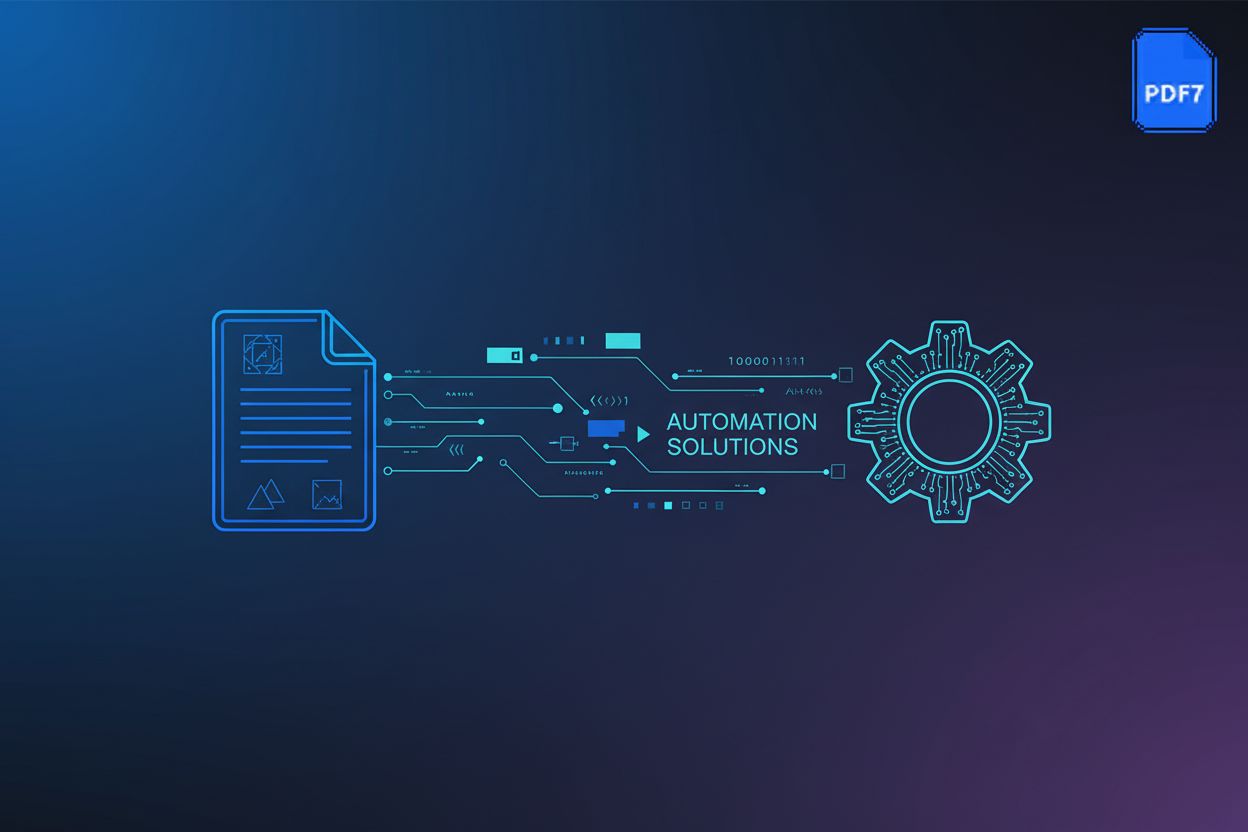Streamline Your Workflow: A Comprehensive Guide to Document Workflow Automation
Understanding Document Workflow Automation
Are you still buried under paperwork? Document workflow automation can help your business navigate the never-ending stack of documents. It reduces frustration and increases productivity across the board.
Document workflow automation uses software to manage documents through predefined processes. These processes include creation, review, approval, distribution, and storage. (Document Control Explained: What Is It & Why It's Important | Accruent) FlowForma states that the goal is to make document processes faster, more reliable, and manageable.
Key components of document workflow automation include:
- Trigger: Starts the automated workflow, like submitting a form or creating a new file.
- Routing: Sends the document to the right people or systems in the correct order.
- Approval: Captures feedback and sign-off from stakeholders.
- Output: Stores, sends, or integrates the approved document into other platforms. Examples include CRM systems like Salesforce, ERP systems like SAP, or cloud storage like Google Drive or Dropbox.
It's important to distinguish between document workflow and document management workflow. Document workflow focuses on the sequence of steps a document goes through. Document management workflow focuses on the long-term storage, security, and retrieval of documents.
Both are needed for efficient operations, compliance, and data integrity. A document workflow automation platform typically incorporates document management functionalities by providing a centralized repository for storing documents, managing versions, and controlling access. This integration ensures that as documents move through automated processes, they are simultaneously being managed effectively for long-term use and compliance. FlowForma highlights that businesses must adopt both strategies to ensure process speed, accuracy, control, and compliance.
A typical document workflow includes these core steps:
- Document Creation: Use templates and data-driven tools.
- Review and Approval: Automate routing and notifications.
- Storage and Organization: Use a centralized digital repository for version control.
- Distribution: Share documents with stakeholders based on rules.
- Archiving and Compliance: Securely archive documents to meet standards.
Understanding these steps sets the stage for streamlining your processes. Next, we will explore the benefits of document workflow automation.
Benefits of Document Workflow Automation
Did you know that inefficient document processes cost companies up to 20% of their revenue? Document workflow automation offers a solution to this common problem. Let's explore the benefits of automating your document workflows.
Document workflow automation significantly boosts efficiency. It reduces manual tasks and administrative burdens. This allows employees to focus on more strategic activities. Faster processing and turnaround times also lead to improved resource allocation.
- Reduced manual tasks: Automation handles repetitive tasks like data entry and routing. This minimizes the need for human intervention. It frees up staff for higher-value work.
- Faster processing times: Automated workflows speed up document handling. Approvals and reviews happen quicker. This reduces delays and accelerates business cycles.
- Improved resource allocation: With reduced administrative overhead, resources can be allocated more effectively. Staff can focus on core business functions. This drives overall productivity.
For example, in retail, automating invoice processing can free up accounts payable staff to focus on vendor relationship management. In healthcare, automating patient record updates allows medical staff to spend more time on patient care.
Automation minimizes errors in document handling. It uses standardized templates and validation rules. This reduces data entry errors and formatting issues. The result is improved data quality across the board.
- Standardized templates: Using pre-designed templates ensures consistency. This reduces formatting errors. It ensures all documents meet company standards.
- Minimized data entry errors: Automating data entry reduces manual input. This lowers the risk of typos and incorrect information. It improves accuracy.
- Improved data quality: Consistent and accurate data leads to better insights. This supports informed decision-making. It enhances overall business performance.
Imagine a finance department where standardized templates ensure that all financial reports are consistent and error-free. Or consider a legal team where automated validation rules prevent critical errors in contract drafting.
Document workflow automation improves team collaboration. It provides real-time editing, comments, and notifications. Centralized access to documents and information ensures everyone is on the same page.
- Real-time editing: Multiple users can work on documents simultaneously. This speeds up the review and approval process. It improves collaboration.
- Centralized access: A central repository makes it easy to locate documents. This eliminates version control issues. It ensures everyone has the latest information.
- Better team alignment: Improved communication and centralized access fosters better team alignment. This reduces misunderstandings. It improves overall project outcomes.
In marketing, real-time collaboration on campaign documents ensures all team members are aligned. In engineering, centralized access to project documents facilitates better coordination and reduces the risk of errors.
Automating your document workflows brings numerous benefits. Next, we'll delve into the practical steps and best practices for implementing document workflow automation in your organization.
Key Features to Look for in Document Workflow Automation Platforms
Imagine documents routing themselves, understanding what's inside, and knowing exactly where to go next. That's the power of key features in document workflow automation platforms. These features streamline processes and improve efficiency.
AI is revolutionizing how we handle documents. It can interpret natural language input and automate document generation. This means less manual effort and faster processing times.
Intelligent routing uses document content to determine the next steps. The system can automatically send invoices to the finance department or contracts to legal, based on their content. AI also detects anomalies and summarizes documents, ensuring critical issues are quickly identified.
For example, in insurance, AI can automatically extract key information from claim forms. It then routes the claim to the appropriate adjuster, significantly speeding up the claims process.
Forget complex coding. Many document workflow automation platforms now offer no-code/low-code configuration. These platforms feature intuitive drag-and-drop interfaces.
This empowers business users to create and adjust workflows without IT support. Teams can quickly adapt processes to changing needs, reducing reliance on IT departments and speeding up deployment.
For instance, a human resources department can create an onboarding workflow with a simple drag-and-drop interface. This allows them to manage new hire paperwork without needing specialized technical skills.
A key feature is seamless integration with existing systems. This includes CRM, ERP, and HRIS platforms. Integration ensures smooth data flow between platforms.
This eliminates data silos and manual intervention. Information is automatically updated across systems. This provides a unified view of all business processes.
For example, integrating a document workflow platform with a CRM system ensures that customer data is automatically updated. When a new contract is signed, the CRM record is updated in real time. This provides the sales team with immediate access to the latest information.
Choosing a platform with these features can transform your document processes. Now, let's explore some common use cases where automation can make a significant impact.
Use Cases for Document Workflow Automation
Is your team spending too much time chasing documents instead of focusing on core tasks? Document workflow automation can transform how your organization handles critical processes. Let's explore some common use cases where automation can make a significant impact.
Automating new hire paperwork streamlines the onboarding process. Digital forms replace manual data entry. This reduces errors and ensures consistency.
- Automated new hire paperwork: New employees complete forms online. The system automatically populates relevant fields in other documents. This reduces administrative overhead and speeds up onboarding. For example, in a large retail chain, new hires can complete all required paperwork on a tablet, and the information auto-populates into HR systems.
- Policy distribution and acknowledgement tracking: Automate the distribution of company policies and track acknowledgements. This ensures all employees receive and understand important guidelines. In a healthcare setting, policy updates can be sent electronically. The system tracks which employees have read and acknowledged the changes, ensuring compliance.
- Streamlining the onboarding process: Automate tasks like background checks and benefits enrollment. This frees up HR staff to focus on employee engagement and training. A manufacturing company can automate the entire onboarding workflow. This includes sending welcome kits, scheduling training sessions, and setting up employee accounts.
Efficient contract review and approval workflows are essential for legal and compliance. Automation ensures adherence to internal and external standards. Policy updates and regulatory disclosures can also be streamlined.
- Contract review and approval workflows: Automate the routing of contracts for review and approval. This speeds up the process and ensures all necessary parties sign off. A financial services firm can automate its contract approval process. This reduces turnaround time and minimizes the risk of non-compliance.
- Policy updates and regulatory disclosures: Automate the distribution of policy updates and track acknowledgements from employees. This ensures compliance with internal and external regulations. An insurance company can automate the distribution of new regulatory disclosures. The system tracks which agents have reviewed and acknowledged the updates.
- Ensuring compliance with internal and external standards: Automate compliance checks and audits. This helps organizations maintain adherence to industry regulations. A construction company can automate safety inspections. The system generates reports and tracks corrective actions.
Automated invoice capture and data extraction can significantly streamline financial operations. Matching invoices with purchase orders and receipts ensures accuracy. It also speeds up approval and payment processing.
- Automated invoice capture and data extraction: Automatically capture invoice data from various sources, such as email attachments and scanned documents. Intelligent OCR technology extracts key information. This reduces manual data entry. A retail company can automatically capture invoice data from its suppliers. This eliminates manual data entry and reduces errors.
- Matching invoices with purchase orders and receipts: Automatically match invoices with corresponding purchase orders and receipts. This ensures accuracy and identifies discrepancies. A manufacturing company can automate the matching of invoices with purchase orders. This reduces the risk of overpayment and fraud.
- Streamlined approval and payment processing: Automate the approval and payment of invoices. This speeds up the process and ensures timely payments. A healthcare provider can automate invoice approvals. This ensures that vendors are paid on time.
Having explored various use cases, let's now turn our attention to the practical steps involved in implementing document workflow automation.
Implementing Document Workflow Automation: Best Practices
Is your document workflow automation stalled before it even starts? Implementing document workflow automation requires careful planning to ensure success. Here are some best practices to guide you through the process.
Start by outlining the entire document lifecycle. This includes all stages, from creation to archiving. Identify key stakeholders and decision points along the way. Highlighting areas where automation can improve efficiency is crucial.
- For example, map out the steps involved in processing an invoice. This would include receipt, data entry, approval, and payment. Identify who is responsible for each step. Then, pinpoint any bottlenecks.
Clarify responsibilities at each stage of the document workflow. Set conditions to trigger document movement. Establish logic-based rules for accountability.
- In a legal setting, a contract might automatically route to the legal department if it exceeds a certain value. If it's below that threshold, it could go directly to a manager for approval.
Tracking workflow performance with analytics is essential. Identify inefficiencies and bottlenecks as they arise. Refine rules and processes over time to improve automation.
- Use built-in analytics to track how long each step takes. Then, identify areas for improvement. For example, if approvals consistently cause delays, consider streamlining the approval process or adding more approvers.
Successful implementation requires continuous improvement. Next, we'll explore how to choose the right document workflow automation platform for your organization.
Tools and Technologies for Document Workflow Automation
Online tools and technologies are revolutionizing document workflow automation, making processes faster and more efficient. Let's explore some of the key tools and technologies available, and how they support broader automation strategies.
Online PDF editors offer a versatile solution for managing and manipulating PDF documents directly in your web browser. With these tools, you can eliminate the need for software downloads. These are often used as complementary tools within a larger workflow, for example, to quickly edit a document before it's submitted for automated approval.
With online PDF editors, you can effortlessly perform a variety of tasks. These include:
- Merging multiple PDFs into a single file.
- Rotating pages to correct orientation.
- Removing unwanted pages.
- Organizing documents for optimal readability.
These features make online PDF editors ideal tools for students and professionals alike who need to efficiently manage and edit their documents on the go.
Online PDF editors also provide tools to compress PDF file sizes, making them easier to share and store. Additional features include converting documents to grayscale, extracting specific pages from a PDF, and even repairing damaged PDF files.
Document conversion services are essential for ensuring compatibility and accessibility across different platforms. These services facilitate the conversion of documents between various file formats, such as Word to PDF or JPG to PDF. These services are critical for ensuring that documents can be seamlessly integrated into automated workflows, regardless of their original format.
This ensures that documents can be easily shared and collaborated on, regardless of the recipient's software or operating system. Conversion services streamline document workflows by removing compatibility barriers.
PDF security features are crucial for protecting sensitive documents with passwords and permissions. These features prevent unauthorized access and modification. These security measures are often configured as part of an automated workflow to ensure that sensitive documents are protected at every stage.
Ensuring data security and compliance is a top priority for many organizations. By implementing PDF security measures, businesses can safeguard confidential information and maintain regulatory compliance.
As we've seen, a variety of tools and technologies are available to enhance document workflow automation. Next, we'll discuss how to choose the right document workflow automation platform for your organization.
The Future of Document Workflow Automation
The future of document workflow automation is already here, transforming how businesses operate. Imagine ai handling your paperwork, freeing up your time for strategic tasks.
Advanced ai algorithms extract insights from unstructured documents. For example, ai can analyze customer feedback forms to identify common issues.
Automated document classification and summarization streamline processes. Law firms can use this to quickly summarize case files, saving time and resources.
This all leads to improved decision-making and risk management.
Hyperautomation combines rpa, ai, and bpm to automate complex processes. This connects various departments and systems throughout an organization.
Automating tasks across different departments ensures greater efficiency and agility.
Businesses are achieving significant improvements by automating tasks.
Citizen developers are empowered to build automation solutions.
This democratizes access to automation technology.
Accelerating digital transformation, citizen developers are changing the landscape.
Document workflow automation promises a future of increased efficiency and streamlined processes. Embrace the change and watch your productivity soar.











